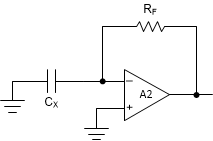TIDUEU6B September 2020 – December 2021 OPA810
- Description
- Resources
- Features
- Applications
- 5
- 1System Description
- 2System Overview
- 3Hardware, Software, Testing Requirements, and Test Results
- 4Design Files
- 5Software Files
- 6Related Documentation
- 7Revision History
2.3.1.1 Circuit Stability Issue
When the unknown impedance is capacitive as shown in Figure 2-3, the feedback transfer function can be calculated using Equation 2.
Equation 2. 

 Figure 2-3 Capacitor Measurement Circuit
Figure 2-3 Capacitor Measurement CircuitThe transfer function implies that a zero is formed in 1/β. The frequency of this zero can be calculated using Equation 3.
Equation 3. 

It can be seen that the zero frequency depends on the unknown capacitance, CX. In Figure 2-4 it can be seen that Aolβ has a rate of closure of 40dB/dec. When the zero frequency is more than a decade below fCL, the phase margin will reduce to zero making the circuit unstable.
 Figure 2-4 Bode Plot of Capacitor Measurement
Figure 2-4 Bode Plot of Capacitor Measurement